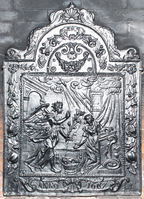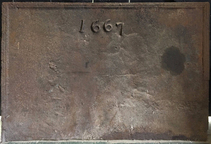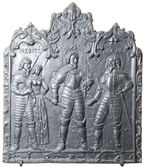-
21
Description: Rectangular central panel with bead edging all round, pictorial representation of the Annunciation by the Angel Gabriel to the Virgin Mary, the angel carries a lily, Mary kneels at a desk, between them is a basket, above them a dove descends from clouds amid sunbeams, to the left is an arch, in the centre a bed, and to the right a window and a canopy; above the panel is a bead-edged arch with a central scallop shell and a floral swag suspended from scrolls; arched rectangular shaped border with fillet edging, a cascade of leaves and fruit (inc. apples, grapes, pears and pomegranates) descending from a wreath, at the base two cartouches conjoined by a scallop shell and containing the inscription; on top a scallop shell between two dolphins.
Notes: A common fireback design originating in the Siegerland of north Germany and made for the Dutch market. A good clear casting. The illustration is copied from Virgil Solis, 'Biblische Figuren',1562.
Copies of this fireback are known.
Inscription: ANNO 1667
Manufactured: in 1667 in the Siegerland area of Germany.
Current location: Bateman's, Burwash, East Sussex, England.
Museum number: 761056 (part of the National Trust museum group)
Citation: Herskamp, W, 2007, Die Eiserne Bibel (Helios, Aachen).
- Attached to series:
- 'Dutch' Miscellaneous Firebacks
- New Testament firebacks
-
1085
Description: Rectangular; rebated ovolo-moulded edging (top, left and half-right sides); top centre, date with unevenly positioned numerals.
Notes: The asymmetry of the side moulding is unusual.
Inscription: 1667
- Decoration tags:
- rectangular (shape)
- rebated ovolo moulding (edging)
- carved stamps
- individual numbers
- text
Manufactured: in 1667 possibly in the Weald area of England.
Current location: Faversham, Kent, England.
- Attached to series:
- Date only firebacks
- 1660s-90s Wealden series
-
1234
Description: Rectangular shape; overlapping laurel leaf on astragal edging; top centre, English royal crown above an arch-shaped laurel garland, the top tied with ribbon; beneath, a palm garland of the same shape but inverted, tied at the bottom, encircling twin letter Cs, one reversed; to left and right of centre, split date, 1667.
Notes: Perhaps commemorating the Peace of Breda which brought the Second Dutch War to an end, the twin letter Cs probably represent King Charles II and Queen Catherine. J. Starkie Gardner (1898, p. 152) misread the date as 1661 and interpreted it as celebrating the Restoration. A similar casting was lot 76, Simon Drieu & Co. auctioneers, Jersey, 20 Jul 2022.
Copies of this fireback are known.
Inscription: 16 67
- Decoration tags:
- rectangular (shape)
- overlapping laurel leaf (edging)
- whole carved pattern
- heraldic
- text
- plants
Manufactured: in 1667 in England.
Current location: not known.
Citation: Gardner, J. S., 1898, 'Iron Casting in the Weald', Archaeologia, 56, 1, pp. 133-164.
- Attached to series:
- Commemorative firebacks
-
97
Description: Arched rectangular shaped central panel with bead edging; naked figure of Mercury/Hermes with winged helmet (petasos), holding a snake-entwined staff (caduceus); he is sitting astride a pair of bellows and blowing a straight trumpet; a twice-bent trumpet lies at his feet; the bellows are pumping air into an organ; to the right of his head is the word, AER (air - Latin); above is a swag of drapery; arched rectangular shaped border with ovolo edging; floral wreath at top with suspended swags of fruit and leaves, including, grapes, pomegranates and apples; inscription, ‘ANNO 1661’, on a scroll at the bottom; scallop shell and sea serpents on top.
Notes: One of a series of firebacks symbolising the four elements.
Copies of this fireback are known.
Inscription: AER / ANNO 1667
- Decoration tags:
- 'Dutch' (shape)
- ovolo (edging)
- whole carved pattern
- mythological
- allegorical
- text
- humans
- objects
Manufactured: in 1667 possibly in the Siegerland area of Germany.
Current location: Nymans, Staplefield Road, Handcross, Slaugham, West Sussex, England.
Museum number: 1206008 (part of the National Trust museum group)
- Attached to series:
- 'Dutch' Miscellaneous Firebacks
- Elements firebacks
-
573
Description: Rectangular with fillet sides and bottom; scrolled foliage on outside edges; date in narrow rectangular panel at bottom; central pictorial representation of four historical figures (see below), three male in mid-17th century armour, and one female; tripple arched top formed of rococo scrolls, a putto forming the middle arch.
Notes: The inscription may relate to the defeat of the Spanish at s'Hertogenbosch (den Bosch - ENDE BUSH) in 1629, and Wesel. von den Driesch states that the figures, from left to right, are: Prinz Fredrik Henrik of Oranje, his daughter, Luise Henriette, Prince Maurice of Nassau, and the Elector Friedrich Wilhelm of Brandenburg, who married Luise Henriette. German craftsmanship may account for the incorrect spelling of Dutch names. Mitford collection, Petworth House.
Copies of this fireback are known.
Inscription: PRESNTZI VAN WESEL ENDE BVSH / 1667
- Decoration tags:
- rectangular with three arches (shape)
- complex individual (edging)
- whole carved pattern
- pictorial
- historical
- royal
- text
- humans
Manufactured: in 1667 possibly in the Siegerland area of Germany.
Current location: Petworth House, Petworth, West Sussex, England.
Museum number: NT/PET/M/64 (part of the National Trust museum group)
- Attached to series:
- 'Dutch' Miscellaneous Firebacks
- Commemorative firebacks




